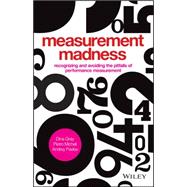
What is included with this book?
DINA GRAY, PhD is a Strategic Business Consultant lecturing on Cranfield University's Executive Education programmes, and she is also Chair of the Regional Advisory Boards for the Innovation Group plc. advising on strategic performance implementation.
PIETRO MICHELI, PhD is Associate Professor of Organizational Performance at Warwick Business School. As a management consultant, he has worked with over 30 organizations, private and public. As a researcher, he has published widely on the subjects of performance measurement and innovation.
ANDREY PAVLOV, PhD is a Lecturer in Business Performance Management at Cranfield School of Management and Director of the Executive MSc in Managing Organisational Performance at Cranfield. He is a regular speaker at conferences around the world, and his work has been published in numerous industry and academic journals.
From the Authors xi
PART I INTRODUCTION 1
1 The Road to Insanity 3
2 Performance and Measurement 13
What is performance measurement? 14
What is performance? 15
What is measurement? 17
Getting the number or changing the behaviour? 20
PART II PERFORMANCE MEASUREMENT 21
3 Measurement for Measurement’s Sake 23
Making things measurable 25
Measures and more measures 27
Competitive measuring 27
Sticky measures 27
Conflicting measures 28
Losing the link to performance 29
Excessive reliance on measures 30
Fixating on measures 31
Getting desensitized to numbers 33
Getting lost in performance data 34
Paying the price 35
Preventing learning and change 37
Learning points 37
Deciding what to measure 38
Designing a robust indicator 40
Managing with measures 41
And finally… 41
4 All I Need is the Right Measure! 43
How difficult can this be? 46
What’s in a name? 46
Knowing the purpose 47
Poor relations 48
It’s in the formula 49
Frequency 50
Where does the data come from? 51
What will you do with the results? 53
How strong are your indicators? 54
Is the indicator measuring
what it is meant to measure? 55
Is the indicator only measuring
what it is meant to measure? 56
Is the indicator definitely the right indicator? 57
Is the indicator consistent regardless of
who measures and when? 58
Can the data be readily communicated
and easily understood? 59
Is any ambiguity possible in the
interpretation of the results? 60
Can and will the data be acted upon? 61
Can the data be analyzed soon enough
for action to be taken? 62
Is the cost of collecting and analyzing data justified? 63
Will the measure encourage any undesirable behaviours? 64
Learning points 66
It’s not just a KPI 66
Pass or fail 67
And finally… 67
5 Comparing Performance 69
Apples and pears 73
Differences in data collection 73
Different datasets 75
Different methodologies 76
Interpretation and presentation 78
Timeliness 80
Special variation 81
Choice and relevance 82
Using data unintended for comparative purposes 83
Yes, but… 84
Moving up the rankings 85
Unintended consequences 89
Learning points 92
Which data to collect? 93
Collection mechanisms 93
Consistency 94
Handling ambiguity 94
And finally… 95
PART III PERFORMANCE MANAGEMENT 97
6 Target Turmoil 99
What are performance targets? 102
When targets go bad 104
Are targets so bad? 106
The main pitfalls 107
When targets do good 114
Clarity and commitment 116
Unexpected benefits 118
Learning points 119
Types of targets 121
Setting targets 122
Feedback 123
Targets and incentives 124
In summary 124
And finally… 126
7 Gaming and Cheating 127
Gaming: what is it? 129
Gaming and cheating 133
What drives gaming and cheating? 137
The pressure to perform 139
Targets – the wrong kind and in the wrong way 141
The climate of competitiveness 142
Types of gaming 144
The number and predictability of gaming behaviours 145
Learning points 149
Relieving the pressure 150
Setting the right kind of target 150
Foreseeing the future 151
Improving data management systems 151
Changing the culture 152
And finally... 154
8 Hoping for A Whilst Rewarding B 157
Common management reward follies 160
Hoping for teamwork whilst rewarding individual effort 160
Hoping for the long term whilst rewarding
short-term gain 162
Hoping for truth whilst rewarding lies 163
Hoping for contribution whilst rewarding outcomes 166
Hoping for budget control whilst rewarding overspend 167
Learning points 169
Targets, rewards and measures 169
Reward people later 171
Avoid negative spillover 171
Systems thinking 172
And finally… 173
9 Failing Rewards and Rewarding Failure 175
Top rewards for top performers 178
Rewarding failure 179
Failing rewards 180
Measurement, rewards and motivation 182
When financial rewards backfire 185
What motivates us? 188
Learning points 192
Motivation and long-term goals 192
Different strokes for different folks 193
The right measures 194
The time to reward 195
Team vs. individual rewards 195
And finally… 196
PART IV CONCLUSIONS 197
10 Will Measurement Madness Ever Be Cured? 199
And finally… 203
References 205
Index 217
The New copy of this book will include any supplemental materials advertised. Please check the title of the book to determine if it should include any access cards, study guides, lab manuals, CDs, etc.
The Used, Rental and eBook copies of this book are not guaranteed to include any supplemental materials. Typically, only the book itself is included. This is true even if the title states it includes any access cards, study guides, lab manuals, CDs, etc.